The Yucatan Peninsula is known for its incredible Mayan ruins. No trip to the region would be complete without visiting at least one archeological site.
I’m pretty sure you’ve heard of Chichen Itza and the Tulum ruins, but you might have just discovered the Coba Ruins in Quintana Roo, Mexico and you’re trying to figure out if they’re worth a visit… did I get that correctly? My answer is yes, absolutely.
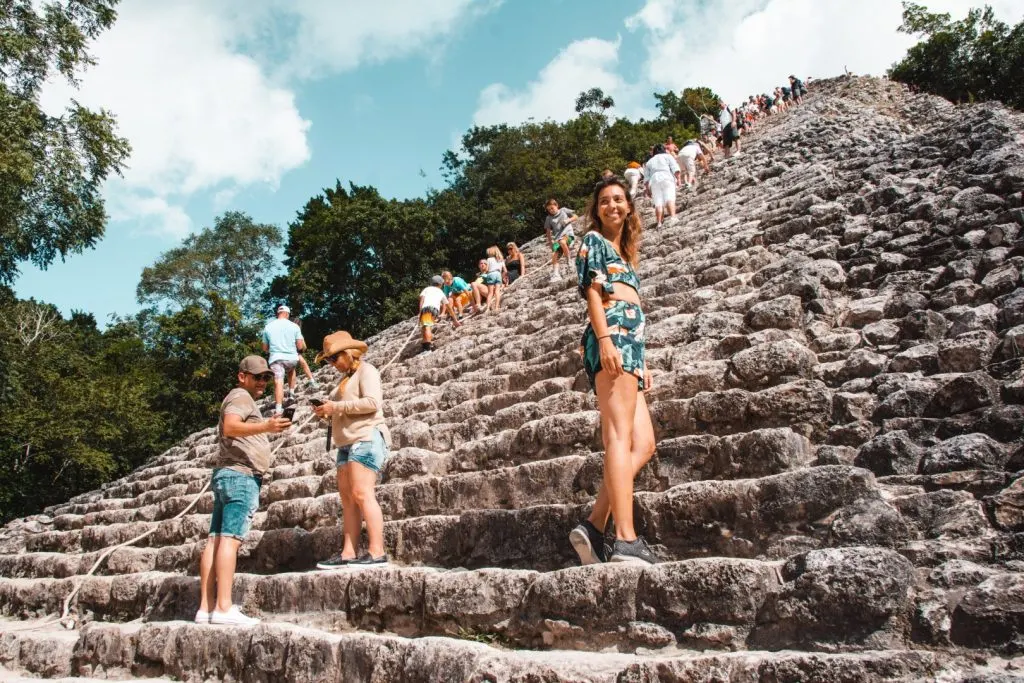
At Coba you won’t find the crowds of Tulum and Chichen Itza, plus you get to climb a Mayan pyramid which is strictly forbidden in most other sites.
Check out this comprehensive guide to visiting the Coba Ruins, and discover everything there is to know about them!
Table of Contents
BEST COBA TOURS
If you prefer saving yourself the hassle of getting to Coba on your own, there are some very cool Coba Ruins day trips from the Riviera Maya that you can join. I personally visited Coba on a tour.
▶️ On the Coba Ruins, Punta Laguna Nature Reserve, Cenote and Mayan Family you’ll get to explore the ruins with a professional guide. Ride a bike around the site, and then head to Punta Laguna, where you’ll kayak on the lake, zipline, and hike. Cool off in a cenote, and spend time in a Mayan community. Lunch is included. ➥ BOOK IT HERE
▶️ On the Coba Multun-Ha Cenote Tulum and Paradise Beach Small Group you’ll visit two archaeological sites. Tour around Coba with a professional guide, and learn about the Mayan at the Tulum Ruins. You’ll also swim in a beautiful cenote, and relax in Paradise Beach. Lunch and roundtrip transfers are included. ➥ BOOK IT HERE
▶️ Choose this Tulum, Coba, Cenote, and Mayan Ceremony Full-Day Tour plus Lunch for a historical experience like no other. You’ll visit the Riviera Maya’s most important archaeological sites, discovering the ancient civilizations. Climb the main pyramid at Coba, take part in a Mayan ceremony, and cool off in a beautiful cenote. ➥ BOOK IT HERE
▶️ The Chichen Itza, Cenote Ik Kil, and Coba Ruins Small Group is the perfect tour if you want to include a trip to Chichen Itza. Learn about the vast site from a guide, and cool off in Cenote Ik Kil before heading to Coba. There, climb the main pyramid to take in the jungle views. Breakfast and lunch are included. ➥ BOOK IT HERE
Private Tours to Coba
▶️ The Exclusive Private Tour Tulum & Coba Just for You is a 7-hour excursion. A professional guide will pick you up at your hotel and drive you to the archaeological sites of Coba and Tulum for a comprehensive tour. Learn about the Mayan civilization and the ruins’ purposes with up to 14 friends. ➥ BOOK IT HERE
▶️ This Full-Day Chichen Itza, Coba and Tulum Private Tour with Lunch is practically a Mayan ruins marathon! Start bright and early with a tour around the Tulum Ruins, perched on a cliff. Then, move on to Coba, a vast site that still allows climbing its pyramid. Relax in Cenote Ik Kil, and end your trip with a visit to Chichen Itza. ➥ BOOK IT HERE
▶️ The Coba Ruins Tour (Private, Half Day) includes hotel pick-up and drop-off, and a guided tour around Coba for up to 15 people. Explore the ruins as you learn about Mayan history, and climb its tallest pyramid. ➥ BOOK IT HERE
If you choose to visit on your own, know that the entry fee to the ruins is 195 MXN (12 USD) in March 2024.
HOW TO GET TO THE COBA RUINS IN MEXICO
The ruins at Coba aren’t far from both Tulum and Playa del Carmen. There are plenty of transportation options available if you are traveling from Tulum or some other parts of the Riviera Maya. Let’s see them all.
Getting to Coba from Tulum
The Coba Mayan ruins are only 29 miles (47 km) from Tulum in the Yucatan Peninsula, which makes them the ideal day trip from Tulum. Coba is located between Lago Coba (Lake Coba) and Lago Macanxoc (Lake Macanxoc).
There are a few ways to go from Tulum to the Coba Ruins.
➤ The first option available to get to Tulum is by rental car and you’ll find that there are plenty of car rental companies in Tulum to get around for a day. Many tourists prefer this option to give them plenty of flexibility.
If you decide to drive to Coba Ruins from Tulum with a rental car, drive through the Quintana Roo Highway 109. The total travel time is around 40 minutes. The address is Carretera Federal Tulum 307.
➤ If you decide to take the colectivo from Tulum to Coba Ruins, you must go to the corner of Tulum Avenue and Calle Osiris Norte. Colectivos usually depart when they’re full, so there’s likely one leaving Tulum every 15 or 20 minutes.
You should expect to pay around 70 MXN for the ride from Tulum to Coba. Also, make sure you get on one that has the “Tulum – Coba” sign on the front, or ask the driver if it’s headed there.
➤ You can also take the ADO bus from Tulum to Coba which is one of the best public transport options available. The ticket costs $15 at the time of writing and departs from the ADO bus terminal in Tulum Pueblo.
You can check the scheduled times for Valladolid, the bus’ final destination, here. The ride takes around 1 hour, and there are bus departures pretty much every hour during the day.
➤ You can also take a taxi to get to Coba. The average cost of a taxi ride to Coba from Tulum is 450 MXN. Make sure you agree on a price before you depart for Coba so you know exactly how much you’ll be paying.
Getting to the Coba Ruins from Playa del Carmen and Cancun
There are also routes available via the ADO Bus if you’re traveling to Coba from Cancun or Playa del Carmen in Quintana Roo, Mexico.
The bus ride from Playa del Carmen takes about 2 hours, and from Cancun it takes around 3 hours. It’s worth the trip, though, as Coba is one of the best Mayan ruins near Cancun you can visit.
HOW TO GET AROUND THE MAYAN COBA RUINS, MEXICO
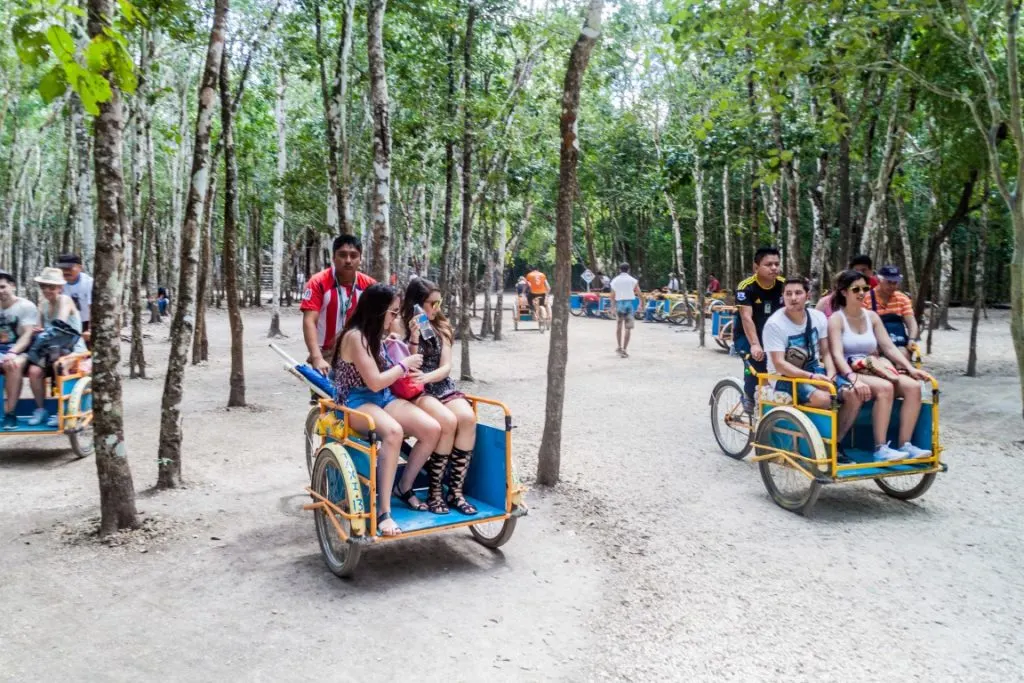
The Coba Archaeological Site is a massive area with plenty to explore. It’s important to know the most efficient way to get around the ruins to ensure that you can make the most of the sights and save energy.
➤ One of the easiest ways to see the Coba Ruins is to explore Coba on foot and it’s really a nice way to get some exercise while also seeing the ruins.
If you intend to see the ruins for a full day, you can take your time and walk at your own pace. The main structure of the site, for example, is about 1.2 miles from the ruins entrance.
If you want to explore more of the attractions of the site, most are a bit farther than 1.2 miles. You might want to look into a different transportation method.
➤ Another option to get around this ancient Mayan city is renting a bike. Bikes are popular among tourists because the bike rental is budget-friendly. Bikes can help you cover more ground as they are a faster way to get around.
The cost of bike rental is approximately 80 MXN per person at the time of writing.
➤ If you want a more convenient way to get around Coba Ruins, you can try the bike taxis. These bike carts are ideal if you don’t want to think about where to go next. Sit back and relax while your guide shows you the attractions you shouldn’t miss.
It’s also pretty fun to ride a bike taxi! The cost of a bike taxi or cart tour is 120 – 150 MXN (about 9 USD) at the time of writing.
A SHORT COBA RUINS HISTORY
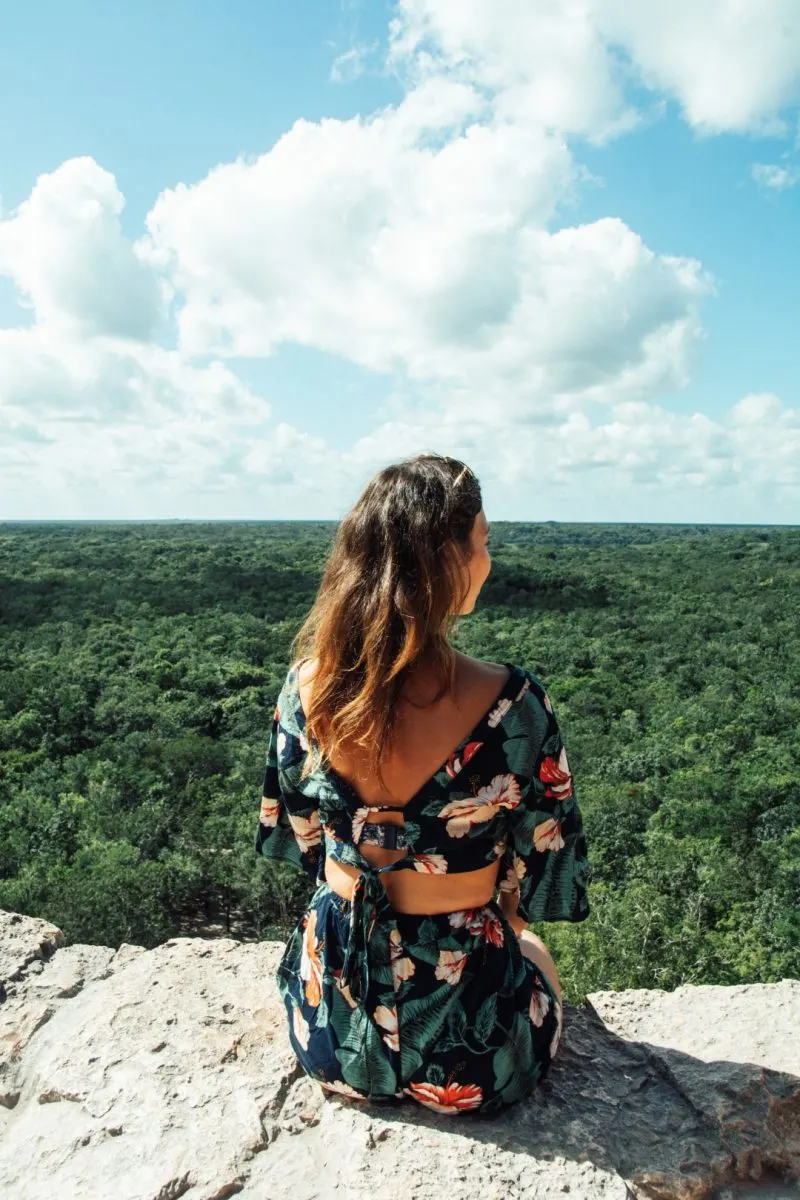
According to archaeological evidence, the first settlement in Coba was around 50 BC to 100 AD (which means Coba is about 2,000 years old!).
It was also known as one of the most important cities for the Mayans in terms of social and political power. This is because it controlled many farmlands and trading routes in the region.
During this period when Coba was an integral part of the Mayan Empire, it was estimated to have up to 50,000 in population. It’s clear the influence from Teotihuacan, which means that Coba communicated with other communities in Central Mexico.
The city maintained its influence for a long long time until the Spanish conquest in the 1500s.
Although the initial excavations at the Coba Ruins site were done in the 1970s, it was not developed into a tourist destination until the 1980s. You’ll see this is a big place – the ancient Mayan ruins site covers a land area of 30 square miles.
CLIMB THE NOHOCH MUL PYRAMID
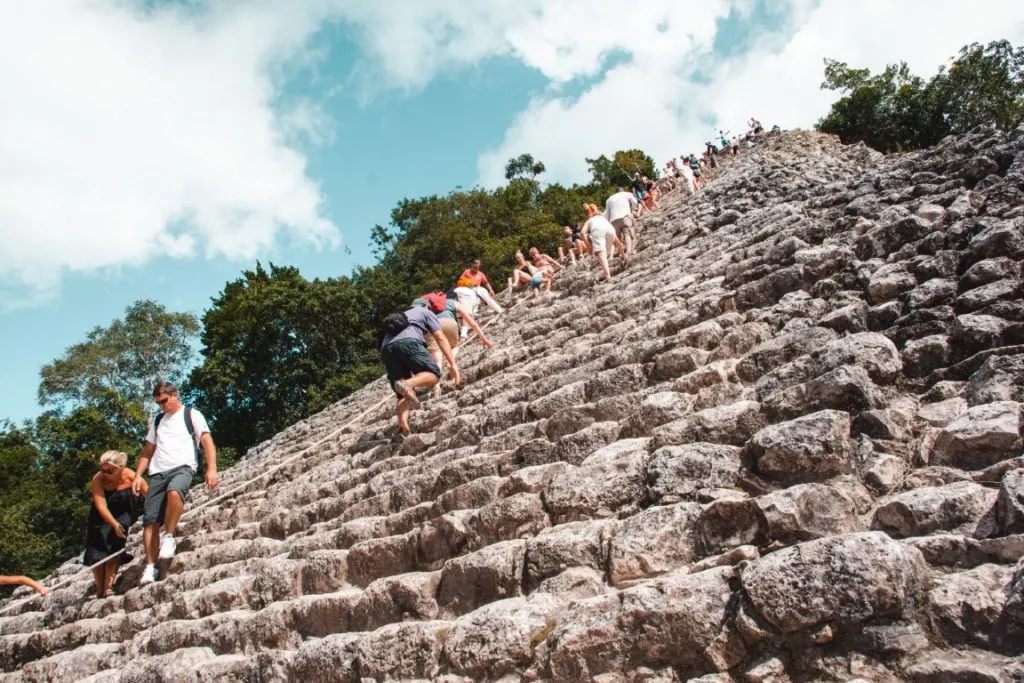
As of January 2025, the pyramid cannot be climbed. Access to the top has been closed during the pandemic and it’s unclear if it will reopen or not.
Nohoch Mul Pyramid is the tallest pyramid in Coba, standing 137 feet tall. The pyramid can be climbed, though it takes 120 steps to get to the top.
In fact, Nohoch Mul Pyramid is the tallest Mayan pyramid in the Yucatan Peninsula, and also the second-highest Mayan pyramid in the world.
Climbing up the Coba pyramid will have you navigating your way through crumbling stone stairs. Thankfully, there is a thick rope that you can use to assist your climb.
However, I don’t suggest attempting the climb if you’re older or not too fit. It’s not the easiest climb, to be honest, and not to frighten you, but there have been a couple of incidents of people falling down the pyramid.
I’m not saying don’t go (I did!), but decide carefully if it’s for you or not.

The effort to climb up the largest pyramid in Coba is worth it when you consider the view that you can enjoy from the top. Jungle everywhere! Climbing the Nohoch Mul pyramid was the highlight of my time visiting Coba, but you need to hurry up.
OTHER SIGHTS IN COBA
The Coba Ruins are a collection of ancient pyramids. There are more things to do in this Mayan site apart from the main pyramid mentioned above!
In particular, there are many smaller pyramids and stone buildings scattered throughout that you shouldn’t miss when visiting Coba.
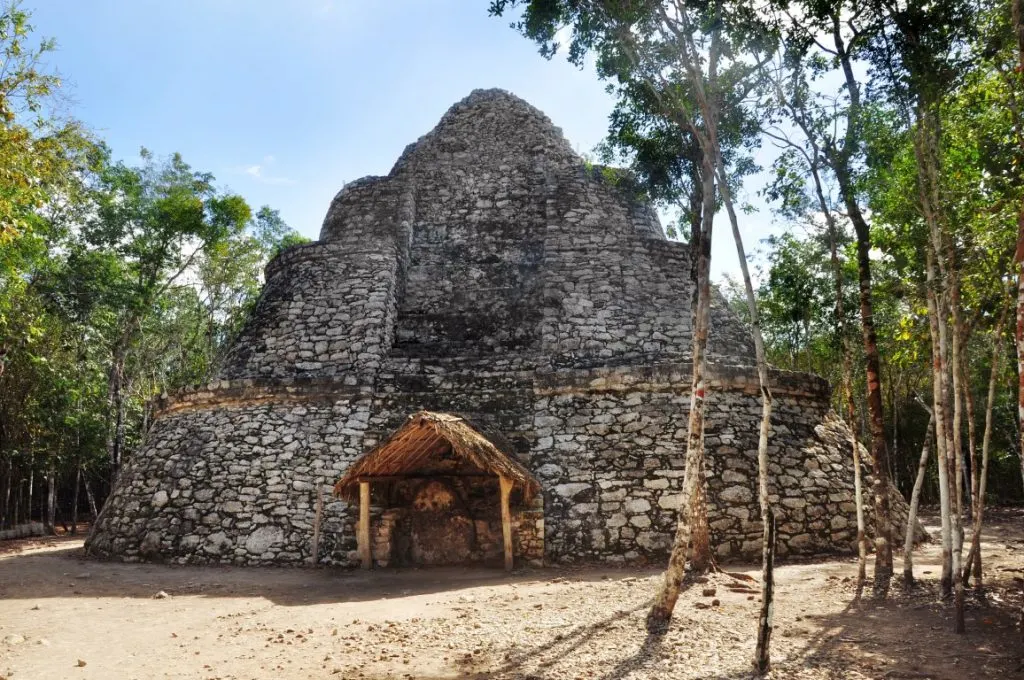
The first one is known as the Coba Group which is a series of structures that are near the entrance to this Maya ruins site. One of these structures of the Coba Group is the Iglesia (Church) and there are also two ball courts.
A Mayan ball court was used to play the traditional game of Mesopotamian ball. Unlike the main pyramid, you won’t be able to climb the Iglesia.
Another must-see sight within the Coba Ruins is the Conjunto de Pinturas. The highlight of this area is the Pyramid of the Painted Lintel. It’s unique because there are beautiful paintings at the top of the temple, which can be seen from afar.
There is another group of structures found within the Coba site that is also a must-see. This is the Macanxoc Group, which consists of 8 stelae and several altars. The presence of plenty of stelae shows that this area was used for spiritual activities.
And then there is the Coba Stelae which are numerous, large stone slabs. They consist of drawings and glyphs, believed to be a way for the ancient Mayans to record important events and historical facts.
Finally, there are the Sacbes, which are also known as the white roads of the ancient Mayan world. Back when the Mayans thrived, Coba was a hub of urban settlements and they were accessible because of roads that were known as sacbes.
Many of these stone causeways were built by the Mayans to aid in commerce activity. There are at least 50 of those jungle paths that were unearthed within the archaeological site of Coba.
HIRING A GUIDE AT THE COBA RUINS
At the entrance of Coba Ruins, you’ll find that there are guides who can be hired on-site. While you’ll already have a guide with you if you visit the ruins with a tour, if you’re going on your own it’s an option worth considering.
Exploring the site with a guide means you’ll get insights and context about the ruins. That’s on top of learning about the city’s inhabitants and their customs! You’ll also discover what each structure’s purpose was.
A guide service for an hour costs around $30, although this is not a fixed price – you’ll have to ask the guides and arrange with them. They’re professional guides, and they usually speak very good English.
If you’re a group, a private tour ends up being quite cheap when you divide the fees between participants!
An alternative is hiring a tricycle ride to explore the vast site, as your driver could act the part of an informal guide.
They’re usually quite knowledgeable, and if your driver is friendly they may be willing to provide insights and teach you about the places. Remember to tip them!
TIPS FOR VISITING THE COBA RUINS
Wear comfortable shoes. The site is massive, and you’ll be doing A LOT of walking around (or cycling!) Having good, walkable footwear is key!
Bring a water bottle. The visit takes a few hours, and whether you decide to walk, cycle, or take a cabi-ped, the heat alone will make you incredibly thirsty.
Hire an on-site guide (unless you’re joining a tour) to make the most of the experience and better understand the site and its history, as well as Mayan culture.
Try to avoid the midday/early afternoon heat (and possible crowds) by visiting first thing in the morning. By noon, you’ll be ready to leave to…
Visit Cenotes! The area surrounding Coba is home to astounding cenotes that you should include in your itinerary. Make sure to save some time to check them out. Some of the best include Multun-Ha, Choo-Ha, and Tankach-Ha.
BEST CENOTES NEAR COBA RUINS
If you’ve been following this blog for a while, you’ll know that cenotes are my favorite part of traveling to the Yucatan peninsula. I’ve already written about plenty of nearby cenotes in Tulum and cenotes in Playa del Carmen and Valladolid.
But if you come to visit the Coba ruins, there are a few nearby cenotes that you shouldn’t miss. The following are some of the best cenotes to visit near Coba. These cenotes are located to the west of Coba village.
Cenote Tamcach-Ha
Cenote Tamcach-Ha is an underground cenote with a couple of jumping platforms that are 5- and 10-meters high, respectively. This is a great cenote to visit after visiting Coba Ruins if you prefer a cenote that is not too crowded.
Cenote Tamcach-Ha boasts crystal-clear water where you can swim or snorkel. To access this Coba ruins cenote, you have to make your way through a small opening in the ground.
Once inside, you can marvel at the impressive rock formations and stalagmites hanging from the ceiling.
This is a very deep cenote of a deep blue color, and the rock ceiling is impressively high. This is not the cenote to go to if you are looking for stalagmites. This perfectly round cavern is really beautiful and, surprisingly, it’s still relatively quiet and calm.
Cenote Tamcach-Ha Opening Hours: Daily from 8 AM to 6 PM.
Cenote Tamcach-Ha Entrance Fee: 100 MXN.
Cenote Choo-Ha

Cenote Choo-Ha is another Coba cenote located off the beaten path. You must brave through a rugged and secluded terrain to get to this cenote, which is surrounded by a naturally dense jungle.
Once you enter the cenote, you’ll find rustic-looking washrooms, toilets, and other facilities. It’s quite clear that they’re not trying to transform this into a modern facility.
Nonetheless, that does not take anything away from the natural beauty of this cenote. You make your way through a low stone wall through a small opening that leads to an underground cavern.
Thankfully, there is a spiral staircase that you can take to safely make your way down the cavern.
Once inside, you can marvel at the impressive rock formations that hang from the ceiling and at the many stalactites and stalagmites you’ll see everywhere.
Unlike Cenote Tamcach-Ha, Cenote Choo-Ha has shallow water which makes it the perfect spot for a leisure swim. The shallow water also makes it a good option for families with small kids!
Cenote Choo-Ha Opening Hours: Daily from 8 AM to 6 PM.
Cenote Choo-Ha Entrance Fee: 100 MXN.
Cenote Multum-Ha
This is the deepest cenote of the three cenotes near the Coba Ruins. This is also a bit farther into the jungle so it’s the hardest to reach of the three nearby cenotes. Cenote Multum-Ha is ideal for snorkeling and, just like Choo-Ha, it features rustic facilities and washrooms.
Since this is also an underground cenote, you’ll enter through a small opening through the rocks and make your way down a spiral wooden staircase.
The entry is somewhat claustrophobic because it’s surrounded by rock walls on both sides. Once you reach the end, though, there is a deck-like platform with railings that enable you to overlook the cenote waters.
At the top of the ceiling, there is a small hole that allows a small amount of light in.
Due to the serene nature of this cenote and the lack of tourists, it offers an intimate experience. If you visit on slow days, you could even have this Coba cenote to yourself!
Cenote Multum-Ha Opening Hours: Daily from 8 AM to 6 PM.
Cenote Multum-Ha Entrance Fee: 100 MXN.
WHERE TO STAY IN COBA NEAR THE RUINS
Luxury Hotel: Coqui Coqui Papholchac Coba Residence & Spa – It boasts an earthy design and it offers top-notch amenities. It’s home to spacious, air-conditioned accommodations with a private bathroom and a terrace. There’s also a swimming pool, a wellness center, a restaurant, and a bar.
Boutique Hotel: Hotel Jungla y Estrellas – This 3-star hotel has an outdoor pool, a terrace equipped with sunbeds, and a spa. Rooms come with a private bathroom with toiletries, and some boast their own balcony. Breakfast is served every morning.
On a Budget: Hotel Itza Coba – This hotel offers double and family rooms with a private bathroom, and it’s located near the ruins. It has a lovely patio and an outdoor swimming pool, offers room service, and it’s pet-friendly (upon request).
I hope this guide is useful to plan your visit to the Coba ruins – for any questions, let me know in the comments below.

DIGINON
Thursday 21st of March 2024
This information is completely outdated. It has been forbidden to clinb the temple for several years. They closed access during COVID. Also, the entrance fee is 195 pesos in March 2024
Stefania Guglielmi
Monday 25th of March 2024
Thank you for your comment! We used to have a box saying that the pyramid is (temporarily?) closed but not sure what happened to it!! We already updated the post.